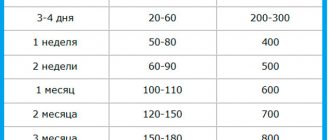The best time to introduce babies to this substance is at six months of age. This is the time when the gastrointestinal tract has already become a little stronger, and now, in addition to breast milk, it can digest a much larger amount of various foods.
But, it should be remembered that you can start giving the product only if the child has already become thoroughly familiar with and accustomed to vegetable purees. There are exceptions when pediatricians advise starting the first complementary foods with cereals. Such measures are resorted to if children have problems with being underweight, regurgitating too often or with stool (too loose). Things are completely different with babies who are bottle-fed. For them, familiarization with the product begins at the age of 4-5 months. Porridges can be gluten-free or those that do not contain gluten in their structure. This element, in fact, is a protein of plant origin (another name is gluten). This protein is quite difficult for a 6 month old baby to digest. When it enters the stomach, it causes bloating, gas, colic and pain.
Sometimes a very rare genetic disease such as celiac disease occurs.
If it is diagnosed in a child, all products containing gluten are completely excluded from his diet. Parents are required to feed according to the special diet prescribed by the doctor. Gluten is found in products in this category such as:
- Wheat;
- Prosyanaya;
- Barley;
- Rye;
- Oatmeal.
The best are corn, buckwheat and rice porridge. They are gluten-free and contain a whole range of vitamins necessary for full development. It is worth noting that for each child, complementary feeding begins with a different porridge, it depends on the individual needs of the body. If rice groats are good for one baby, then for another, buckwheat will be better, especially if the latter’s stool is too thin.
Why is it time
There are a number of reasons why you can be sure that it is really time for the first complementary feeding:
- The digestive organs of the toddler are almost completely formed, and it is simply necessary to complicate the work of the digestive system for proper peristalsis and the production of enzymes.
- The child began to spend significantly more energy than before. This is due to the fact that the toddler’s motor skills have improved and he has learned to sit. And he began to spend less time on rest; most of the day is spent on active pastime. Therefore, the portion that he previously received with breast milk is now not enough, there are not enough calories. And it's time to introduce new products.
- The toddler shows interest in everything he sees and really wants to be with you at the dinner table. He is already starting to reach for the products he noticed on him.
- The baby's first teeth are appearing and for their proper development it is better to eat thicker food and start eating from a spoon.
I started adding new foods to my son when he was six months old. He ate with such appetite that I was even afraid that the child had been hungry before. But the doctor reassured me and said that my baby just really liked the taste of vegetable puree. He made this conclusion based on the normal development, weight, height, and good tests of the child. Although there are cases when mother’s milk is really small or has insufficient fat content.
National team
What vegetables should be introduced into a child’s diet after six months? Nutritious potatoes are given little by little at 7 months. But keep in mind that in puree its share should be 30–40%, since starch puts a lot of strain on the digestive organs. From 8–9 months, try onions, exclusively boiled and in combination with other vegetables. At 9 months it’s the turn of boiled beets. Be careful if your baby has loose stools. This vegetable has a laxative effect, which can aggravate the problem.
Which vegetables to give to a child under one year old and in what order, of course, is up to you to decide. The main thing is that the baby’s first menu is healthy, moderate and does not cause harm. And if you are in doubt, be sure to consult your pediatrician.
Baby's diet
Now the child receives five meals a day with breaks of four hours. In addition, feeding at night is still acceptable.
It is better to introduce a new product before the second breakfast. It should be given in small portions and then supplemented with breast milk. It is very important that complementary feeding occurs before lunch. It is possible that the child is allergic to a particular product. Therefore, it is extremely important to introduce new foods in the first half of the day, so that there is time to notice manifestations of a negative reaction to complementary foods. At night it will be much more difficult to notice this in time. Then, with good tolerance, the volume of new food gradually increases and after a month or a month and a half, complementary foods will replace one breastfeeding.
At this time, artificial children's diet expands even more, but for babies it is also five times a day.
We introduce complementary foods correctly
It is very important to start introducing complementary foods on time, correctly and in accordance with age standards. What you should know if it’s time for your baby’s first complementary feeding:
- Start with vegetable purees. It is better to steam them and then chop them. This way you will preserve as much as possible everything useful that is contained in them.
- The dish should be at the optimal temperature, thin rather than thick, and have a uniform structure.
- First of all, the baby’s food should be one-ingredient. Do not mix different products. In such cases, it will be very difficult to track what exactly the allergy manifested itself to.
- Teach your little one to immediately eat from a spoon and drink from a cup or a special drinking bowl.
- The feeding process should take place in a sitting position.
- You need to cook for the baby without adding salt and sugar.
- Give complementary foods in the first part of the day, before the main meal, on an empty stomach.
- There should be one new product. When the baby’s body adapts to it, it is the turn of the next representative of this product group to get on the child’s table.
- First, you give the baby half a teaspoon and, under good circumstances, gradually increase this portion and after a month you reach 140 grams at a time. Then the time comes to completely replace feeding with mother’s milk with complementary foods.
- It is important that at the time the new product is introduced, the little one feels great; he does not have to get vaccinated in the next week (or it was not done earlier than a week ago).
- Along with food, increase your toddler's drinking. Try giving him an infusion of rose hips, chamomile, dill, and raisin water. The first juices and compotes are introduced with caution.
Zucchini debut
Ideally, your child’s first vegetables should be traditional not only for your region, but also for your family. In this sense, zucchini is a universal choice. It can be introduced into the diet from 5–6 months. It does not cause allergic reactions and does not irritate the mucous membranes. Zucchini is easily and completely absorbed, gently stimulating the secretion of gastric juice and intestinal function. It is rich in vitamins A and C, potassium, calcium and magnesium. All this makes the baby’s immune defense much stronger.
What can you feed a 6 month old baby?
At this age, all children already receive complementary foods, regardless of the type of food. However, their diet is significantly different. And this is natural, because some are just trying something new for the first time, while others have already expanded their menu for two months.
Breastfed baby
Now the time has come to expand the diet of the little ones who eat only mother's milk. The first products that will appear on the table of a little gourmet will be pureed vegetables. Moreover, the first representatives will be zucchini and cauliflower. Only then will the carrots and potatoes come. It is important to remember that we are introducing one vegetable at a time. And we don’t replace him for two weeks. For the first complementary foods, less allergic representatives of each food group are selected in order to reduce the risk of a negative reaction from the body to a minimum.
Prepare only from fresh, whole vegetables, without dents or rotten areas. It is best to steam them, this way you will preserve as much as possible everything valuable that they contain. After cooking, grind the product until a homogeneous mass is formed. It is better not to add salt.
For the first time, give your baby small portions, no more than a teaspoon, but it’s better to start with even half. Don't be upset if your baby doesn't want to eat new foods. Maybe he just didn't like the taste. Also, don't worry too much if you have an allergy. You can return to this product again in a month.
Give complementary foods before 12 noon, watch the body’s reaction for at least a day. Food should be at the optimal temperature (neither cold nor hot).
For the first time, I introduced zucchini puree to my toddler’s complementary foods. He liked it. Two weeks later I introduced cauliflower, but the baby’s reaction was not the same. My son clearly liked the zucchini better.
Baby on artificial feeding
The menu for these children already includes vegetable purees, cereals and fruit purees. Now it’s time to introduce dairy products, but only very carefully (use when preparing porridges, dilute half with water); egg yolk; lean meat (in the form of puree); It is allowed to add oil to prepared dishes. It is allowed to introduce gluten porridges, but it is better to hold off with semolina.
A child on artificial nutrition can now safely be given most juices. The exceptions will be representatives of red fruits, exotic and citrus fruits. Homemade juices should be diluted halfway with water.
For such babies, five meals a day are also typical. And you should not give any snacks in between the main meals, as this will harm your little one. Accustom your child to a routine, let feeding be strictly at the same time every day.
I also recommend reading:
“When to introduce meat into complementary foods for a child”;
“Zucchini for feeding infants”;
“Buckwheat porridge for feeding a baby”;
“Which puree is best to prepare for the first complementary feeding”
“Can I give my baby juice?”
What to do if a child stops eating vegetables and fruits?
A child’s body, like no one else, knows what it needs, and therefore, if your baby suddenly stops trying fruits and vegetables, then you should not panic. He just has the right, like you, not to want them at the moment.
And moreover, most likely, the vitamins and microelements that he has already received are enough for him. And after a while, without your persistent persuasion, he will again return his interest in these products.
Example menu
Some are just introducing their first complementary foods, while others have already tried a lot. We present to your attention possible daily diets for children.
Naturally fed children
- Breast milk (approximately 200 ml) – first meal (around 6 am).
- At 10 am, the baby will be given porridge (for example, buckwheat) - 150 grams, about 50 ml of juice from already familiar fruits.
- For lunch, which comes at 2 p.m., one-ingredient vegetable puree – 150 grams – is ideal. Supplement your baby with breast milk - 50-70 milliliters.
- The baby can have dinner at 6 pm with one-ingredient fruit puree in a volume of 50 grams. The little one should drink it with mother's milk - 150 ml.
- Before going to bed, at 10 o'clock at night, the baby needs to be fed breast milk - 200 ml.
It is worth remembering that children with this type of nutrition are just starting to be introduced to complementary foods during this period. Therefore, at first these portions are much smaller, and the volume of milk is larger.
Formula-fed babies
- At 6:00, prepare the baby's milk formula - approximately 200 ml.
- At 10:00 – porridge cooked in water – 150 grams, 60 ml of juice.
- For lunch, at about 2 o'clock, offer the little one 170 grams of vegetable puree, half an egg yolk.
- For the first dinner, at 6 p.m., feed the child 30 grams of cottage cheese and 40 grams of fruit puree. Give the toddler 150 ml of the mixture.
- At 10 o'clock at night, give the baby an adapted mixture (200 ml).
Be sure to follow all rules and regulations for introducing complementary foods. Only thanks to this, the baby will better accept new foods, and you will reduce the risk of developing allergies to a minimum. This way you will help your baby easily enter the world of more adult food, help him eat from a spoon and drink from a cup. Only with your help will the child be able to grow up healthy and happy.
Recommended reading:
- A child's daily routine at 6 months;
- What should a 6 month old baby be able to do?
- What toys does a 6 month old baby need?
Dishes for six-month-old children
In order for a child to have a complete diet at 6 months, the food must be varied. Take advantage of healthy cooking recipes.
Carrot puree:
- Peel the carrots, cut into cubes, add hot water.
- Simmer over low heat with the lid closed until all the liquid has boiled away.
- Beat with a blender, add a little breast milk, boil for 2-3 minutes.
- Season with butter.
Buckwheat porridge:
- Rinse the cereal, dry it, and pass through a coffee grinder twice.
- For 100 ml of water, take 1 tsp. powder, cook for 10 minutes.
- Season with milk or butter if desired.
Cauliflower puree:
- Sort and finely chop 100 g of inflorescences.
- Pour 100 ml of water, cook until soft.
- Add 40 ml breast milk, 0.5 tsp. vegetable oil, beat with a blender.
Dried fruits compote:
- Sort, rinse and soak 30 g of dried apricots for two hours.
- Boil half a liter of water, add dried fruits, cook for 15 minutes over low heat. Leave for 1.5 hours to infuse, cool and strain twice.











